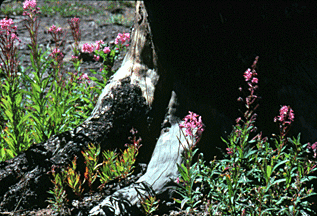 As
I waited for breakfast–eggs benedict, toast and coffee–I pondered the
power of the fire. I couldn't imagine the searing heat. It must have been
like standing in front of a thousand blazing bonfires. As
I waited for breakfast–eggs benedict, toast and coffee–I pondered the
power of the fire. I couldn't imagine the searing heat. It must have been
like standing in front of a thousand blazing bonfires.
The sunlight streamed through the trees allowing for a healthy growth of
underbrush and grazing area for our horses. Thousands of Queen Anne's Lace
blossoms blanketed the forest floor and spilled out into the adjacent
meadow. We camped on what seemed like an island surrounded on three sides by
the waters of Mist Creek, and boggy areas, due to so much rain. And then
there was the wind, always and incessantly, the wind.
 The
dry bare bones of what once was a magnificent forest surrounded us. This was
Yellowstone without the crowds, a place where man is secondary and
subservient to nature–the other side of the world from the fuming geysers
and geothermal mud pools and far from the souvenir shops and tourist inns. The
dry bare bones of what once was a magnificent forest surrounded us. This was
Yellowstone without the crowds, a place where man is secondary and
subservient to nature–the other side of the world from the fuming geysers
and geothermal mud pools and far from the souvenir shops and tourist inns.
The recovery from the fires began almost immediately, with plants such as
fireweed appearing in a matter of days after a fire had passed. While
surrounding national forests did some replanting and even dispersed grass
seed by airplane, Yellowstone’s regeneration was so complete that the
National Park Service didn’t attempt replanting. Wildflowers continued to
blanket the burned areas years after the fires since seeds had little
distance to travel and plant roots remained unharmed by the heat. Next:
Day 3-4 |
